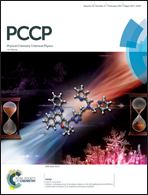Abstract
Accurate prediction of melting points of ILs is important both from the fundamental point of view and from the practical perspective for screening ILs with low melting points and broadening their utilization in a wider temperature range. In this work, we present an ab initio approach to calculate melting points of ILs with known crystal structures and illustrate its application for a series of 11 ILs containing imidazolium/pyrrolidinium cations and halide/polyatomic fluoro-containing anions. The melting point is determined as a temperature at which the Gibbs free energy of fusion is zero. The Gibbs free energy of fusion can be expressed through the use of the Born–Fajans–Haber cycle via the lattice free energy of forming a solid IL from gaseous phase ions and the sum of the solvation free energies of ions comprising IL. Dispersion-corrected density functional theory (DFT) involving (semi)local (PBE-D3) and hybrid exchange–correlation (HSE06-D3) functionals is applied to estimate the lattice enthalpy, entropy, and free energy. The ions solvation free energies are calculated with the SMD-generic-IL solvation model at the M06-2X/6-31+G(d) level of theory under standard conditions. The melting points of ILs computed with the HSE06-D3 functional are in good agreement with the experimental data, with a mean absolute error of 30.5 K and a mean relative error of 8.5%. The model is capable of accurately reproducing the trends in melting points upon variation of alkyl substituents in organic cations and replacement one anion by another. The results verify that the lattice energies of ILs containing polyatomic fluoro-containing anions can be approximated reasonably well using the volume-based thermodynamic approach. However, there is no correlation of the computed lattice energies with molecular volume for ILs containing halide anions. Moreover, entropies of solid ILs follow two different linear relationships with molecular volume for halides and polyatomic fluoro-containing anions. Continuous progress in predicting crystal structures of organic salts with halide anions will be a key factor for successful prediction of melting points with no prior knowledge of the crystal structure.


 Please wait while we load your content...
Please wait while we load your content...